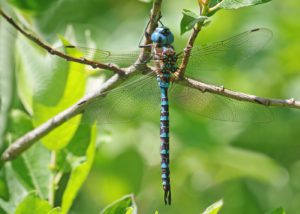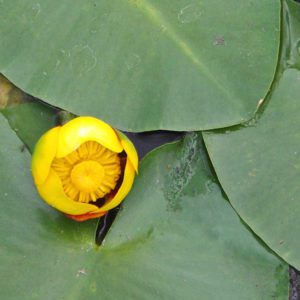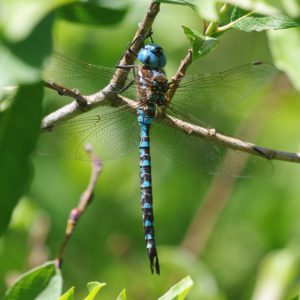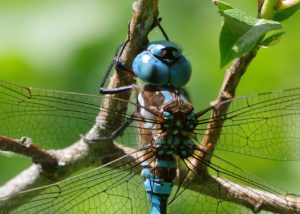Howdy, BugFans,
The BugLady had a great June, hitting the trails and photographing insects. Not surprisingly, many of the insects that wandered past her lens were dragons and damsels, so “Closed for June” may morph into “Odonates for July.”
Isn’t this a spectacular animal!!! BugFan Freda (aka the Dragonfly Whisperer) found it and then showed it to the BugLady.
A few words about Freda’s discovery. First, she wasn’t looking for it, and the spot where she found it does not look at all auspicious from the road (it’s a tiny, gravel parking lot surrounded by shrubs and small trees). She stopped and looked because … well … because she did. The BugLady suspects that Freda is tuned into the zinging of the Cosmos.
Second, the Spatterdock Darner isn’t even on the list for the county she was in (find county lists under the map icon at the lower right-hand corner at http://wiatri.net/inventory/odonata/). In fact, it’s only been recorded in a few counties in the central and southeastern parts of Wisconsin.
Third, as she explored the vicinity a little more, she found more Spatterdock darners, possibly breeding, and she found another unlisted darner. The moral of the story is that we should, metaphorically, stop and smell the roses/odonates. If our travels take us by that low spot in the road where a guard rail marks a little pool or stream, or past a big swamp where we always see dragonflies in the air, we should pull off and take a look (with a nod to poison ivy, ticks, mosquitoes, deer flies, soft shoulders, and No Trespassing signs).
Spatterdock, AKA Yellow pond lily and Bullhead lily (Nuphar advena), is a floating-leaved aquatic plant that’s rooted in the bottom of the pond. Spatterdock Darners AKA, Spring Blue Darners (Rhionaeschna mutata), are dragonflies in the family Aeshnidae. Until 2003 they were classified with the mosaic/blue darners in the genus Aeshna (to review “mosaic darners,” see this episode about the Green-striped Darner https://uwm.edu/field-station/green-striped-darner/), but now they’re in a genus of tropical darners.
[Short grammatical aside: the “c” in the genus name keeps popping in and out. Absent in family Aeshnidae; absent in the genus Aeshna; present in darner genera Rhionaeschna, Basiaeschna, and Gomphiaeschna. It’s not just the BugLady’s capricious spelling.]
This is a big dragonfly, up to 3” long, that one source described (perhaps unnecessarily?) as “very blue.” Its eyes are distinctive (but are shared by the equally-awesome Blue-eyed Darner http://wiatri.net/inventory/odonata/SpeciesAccounts/SpeciesDetail.cfm?TaxaID=170, a genus member that is also a Wisconsin rarity). Females are slightly duller in color, and there are some brown form females. Also distinctive is its flight period – as one of its common names suggests, this is an early dragonfly, aloft in Wisconsin from late May through June, before most of the mosaics that it could be confused with.
They’re found over a pretty large chunk of geography – Ontario to Kentucky, and then west to the Mississippi River – but they aren’t common anywhere within that range. Their global conservation status is listed as “secure,” but they are considered endangered or threatened in most of the states where they occur. Ontario Odonata calls them “one of Ontario and Canada’s rarest dragonflies.”
Habitat plays a role in that story. Although they not as closely linked to water lilies as Lilypad Forktails are (https://uwm.edu/field-station/a-species-on-the-march/), they will use water lilies if they’re available. Their habitat requirements are narrow – for reproduction, they prefer shallow, peaty, fish-free ponds, backwaters, open marshes, boggy waters, and sometimes ephemeral wetlands with lots of aquatic vegetation and with woody edges, and they don’t stray far away from those spots as adults. Such wetlands used to be more common, but early settlers in this and other states put a lot of energy into draining and filling them. Presumably, the species is rare in Wisconsin because it is new here and is just establishing populations.
It’s hard to make management plans for a species when we just don’t know that much about them. Spatterdock Darner populations can be scarce and local – and transient – disappearing from sites they had previously occupied. In one study, Minnesota researchers failed to locate them in an area where they had been reported just a year before, despite searching 25 likely wetlands in the area. The researchers suspected that fish may have been introduced (not necessarily by humans – waterfowl carry fish eggs on their feet and in their guts) and were eating the naiads, but changes in water chemistry, pollution, oxygen levels, sediment, ground water, etc. may also have affected the breeding sites.
Much of what we know about Spatterdock Darners comes from the observations of Edward Bruce Williamson, a Michigan banker who was, in the early days of the 20th century, an acclaimed dragonfly expert. He found Spatterdock Darners while surveying Vanemon Swamp in Indiana. Writing for the Entomological News (July 8, 1908) he said, “In Wells County, Indiana, are a few remnants of a the old swamps which fifty years ago made the chills and ague of this county a constant menace to the early settlers and a perennial joke for those too wise to invade such an inhospitable wilderness. On June 23 [1907] I was at the marsh early in the morning. As soon as I arrived I noticed Aeshnas flying low over the marsh. A small patch of spatterdock in open water was repeatedly visited, the Aeshnas flying slowly in and out, with much stationary fluttering among the leaf stems. On bright mornings when the eastern sky was clear they were hunting over the west side of the marsh at 4:45 o’clock. One cloudy morning they did not appear at all. After 9 or 10 o’clock their visits to the marsh were rare and they were more wary, leaving the marsh when any attempt was made to approach them and flying directly to or above the tree tops. Aeshna mutata spend most of the day after 9 or 10 A.M. either resting in the trees or flying about over the tree tops, probably the latter.”
[He also wrote that “In early spring dainty crustaceans (Brachypus vernalis) [fairy shrimp] in half invisible schools pulsate their aimless ways.”]
Adults catch flying insects in sunny patches at wooded edges, and males patrol for females over open water or along its edges. In Dragonflies through Binoculars, Dunkle says that “Males patrol low over the vegetation with a leisurely, erratic flight for 10 to 15 minutes at a time, paying special attention to flowers of plants such as spatterdock.” According to the Massachusetts Division of Fisheries and Wildlife’s Natural Heritage and Endangered Species Program, “Spatterdock Darners are active on sunny days. Males patrol breeding sites, typically flying lengthy beats several feet above the water’s surface. When more than one male is present, aggressive interactions are frequent and often end with one male chasing another high over the tree tops and out of sight. The appearance of a female generally results in a moment of fevered chaos as one or more males tries to seize the female. Once successfully coupled, the pair flies off high into the nearby woodland to mate.
Spatterdock females oviposit (lay eggs) in emergent or aquatic vegetation at the water’s surface. Females have been observed ovipositing in the stems of spatterdock (Nuphar sp.), pondweed (Potamogeton sp.), and the dead stalks of cattails (Typha spp.). The eggs probably hatch within 30 days, but the nymph may take as long as 3–4 years to reach maturity.”
The naiads hatch and don’t stray far from their natal plant, stalking their prey as they climb around in the thicket of underwater stems.
The BugLady has heard that there might be a 12-Step Program for dragonfly enthusiasts (but -– why???). An alternative to the Program might be a new camera lens or a pair of those nifty binoculars that allow you to focus on dragonflies that are only a few feet away. Group therapy will be provided for dragonfly addicts at the Riveredge Nature Center annual Dragonfly Count (this year, combined with the Butterfly Count), which will be held on July 11, from 9:00 a.m. to 3:00 p.m. Come for part or all of the day, and bring your own munchies, sunscreen, and plenty of water. For more information or to register, contact Mary at mholleback@riveredge.us or 262-416-1224. Pre-registration is required, as are face masks while checking in, while indoors and where social-distancing is difficult outdoors. (A $5 donation per attendee is welcomed.)
Kate Redmond, The BugLady
Bug of the Week archives:
http://uwm.edu/field-station/category/bug-of-the-week/




